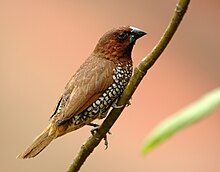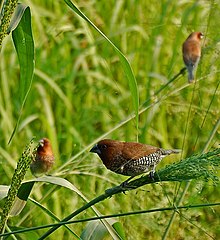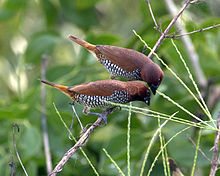Frequency-dependent selection is an evolutionary process by which the fitness of a phenotype or genotype depends on the phenotype or genotype composition of a given population.

The bronze mannikin or bronze munia is a small passerine bird of the Afrotropics. This very social estrildid finch is an uncommon to locally abundant bird in much of Africa south of the Sahara Desert, where it is resident, nomadic or irruptive in mesic savanna or forest margin habitats. It has an estimated global extent of occurrence of 8,100,000 km2. It is the smallest and most widespread of four munia species on the African mainland, the other being black-and-white, red-backed and magpie mannikin. It co-occurs with the Madagascar mannikin on the Comoro Islands, and was introduced to Puerto Rico. Especially in the West Africa, it is considered a pest in grain and rice fields. It is locally trapped for the pet bird trade.
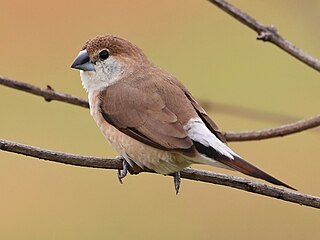
The Indian silverbill or white-throated munia is a small passerine bird found in the Indian Subcontinent and adjoining regions that was formerly considered to include the closely related African silverbill. This estrildid finch is a common resident breeding bird in the drier regions of the Middle East and the Indian Subcontinent. It has also been introduced into many other parts of the world and has become established in some areas. They forage in small flocks in grassland and scrub habitats.
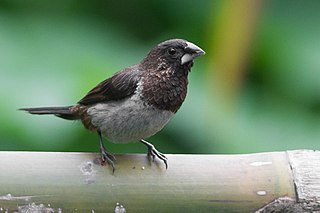
The white-rumped munia or white-rumped mannikin, sometimes called striated finch in aviculture, is a small passerine bird from the family of waxbill "finches" (Estrildidae). These are not close relatives of the true finches (Fringillidae) or true sparrows (Passeridae).

The black-throated munia or Jerdon's mannikin is a small passerine bird. This estrildid finch is a resident breeding bird in the hills of southwest India, the Western Ghats, Eastern Ghats and Sri Lanka.

The chestnut munia or black-headed munia is a small passerine. It was formerly considered conspecific with the closely related tricoloured munia, but is now widely recognized as a separate species. This estrildid finch is a resident breeding bird in Bangladesh, Brunei, Cambodia, China, India, Indonesia, Laos, Malaysia, Burma, Nepal, the Philippines, Singapore, Taiwan, Thailand, Vietnam and Hawaii. It also has been introduced to all the Greater Antilles and Martinique in the Caribbean.

Lonchura is a genus of the estrildid finch family, and includes munias and mannikins. They are seed-eating birds that are found in South Asia from India, Bangladesh, Sri Lanka east to Indonesia, Papua New Guinea, and the Philippines. The name mannikin is from Middle Dutch mannekijn 'little man', and also the source of the common name of the family Pipridae, manakin.

A herd is a social group of certain animals of the same species, either wild or domestic. The form of collective animal behavior associated with this is called herding. These animals are known as gregarious animals.

The red-browed finch is an estrildid finch that inhabits the east coast of Australia. This species has also been introduced to French Polynesia. It is commonly found in temperate forest and dry savannah habitats. It may also be found in dry forest and mangrove habitats in tropical region.
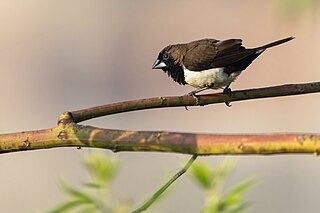
The Javan munia is a species of estrildid finch native to southern Sumatra, Java, Bali and Lombok islands in Indonesia. It was introduced in Singapore and the Malay Peninsula; It inhabits subtropical and tropical dry shrubland and grassland habitat. It has been assessed as Least Concern on the IUCN Red List.

The dusky munia is a species of estrildid finch which is endemic to Borneo. It is also commonly referred to as the Dusky mannikin and the Bornean munia. It is in the family of perching birds (Passeriformes) and is in the genus Lonchura. It is a monotypic species, and there are no subspecies in the genus.
The western alpine mannikin also known as Snow Mountain mannikin or western alpine munia is a small, approximately 11.5 cm long, estrildid finch. Both sexes are similar with dark brown plumage, black face, buff chest and black-barred white abdomen. The young has black bill, dark brown plumage and buffy-white below.

The hooded mannikin or hooded munia, also known as the New Britain mannikin or Sclater's mannikin, is a species of estrildid finch found in New Britain and New Guinea.

The chestnut-breasted mannikin, also known as the chestnut-breasted munia or bully bird, is a small brown-backed munia with a black face and greyish crown and nape. It has a broad ferruginous breast bar above a white belly. The species is found in Australia, New Caledonia, Indonesia, and Papua New Guinea. This species has also been introduced to French Polynesia.
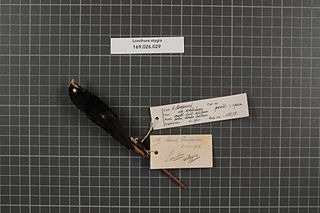
The black mannikin or black munia is a species of estrildid finch found in New Guinea, from Mandum to Lake Daviumbu, Papua New Guinea. It is commonly found in flocks of maximum 20 birds, inhabiting savannas, wetlands, but sometimes they were also seen at rice crops.

The black-breasted mannikin or black-breasted munia is a species of estrildid finch endemic to West Papua, Indonesia. It has an estimated global extent of occurrence of 20,000 to 50,000 km2. It is found in subtropical/ tropical lowland dry shrubland and high altitude grassland habitat. The status of the species is Least Concern.

The tricoloured munia is an estrildid finch, native to Bangladesh, India, Sri Lanka, Pakistan, and southern China. The species has also been introduced to the Caribbean, in Trinidad, Jamaica, Hispaniola, Puerto Rico, Cuba, and Venezuela. This species, like the chestnut munia has been known as the black-headed munia. Immature birds have pale brown upperparts, lack the dark head found in adults, and have uniform buff underparts that can be confused with immatures of other munias such as the scaly-breasted munia.

Evolutionary mismatch is the evolutionary biology concept that a previously advantageous trait may become maladaptive due to change in the environment, especially when change is rapid. It is said this can take place in humans as well as other animals.

The pictorella mannikin, pictorella munia, or pictorella finch is small brown and grey finch with a grey bill and distinctive scaly white breast plate which is endemic to northern Australia. It is a seed-eater found in pairs and small flocks in dry savannah and subtropical or tropical dry lowland grassland.
Vigilance, in the field of behavioural ecology, refers to an animal's monitoring of its surroundings in order to heighten awareness of predator presence. Vigilance is an important behaviour during foraging as animals must often venture away from the safety of shelter to find food. However, being vigilant comes at the expense of time spent feeding, so there is a trade-off between the two. The length of time animals devote to vigilance is dependent on many factors including predation risk and hunger.
